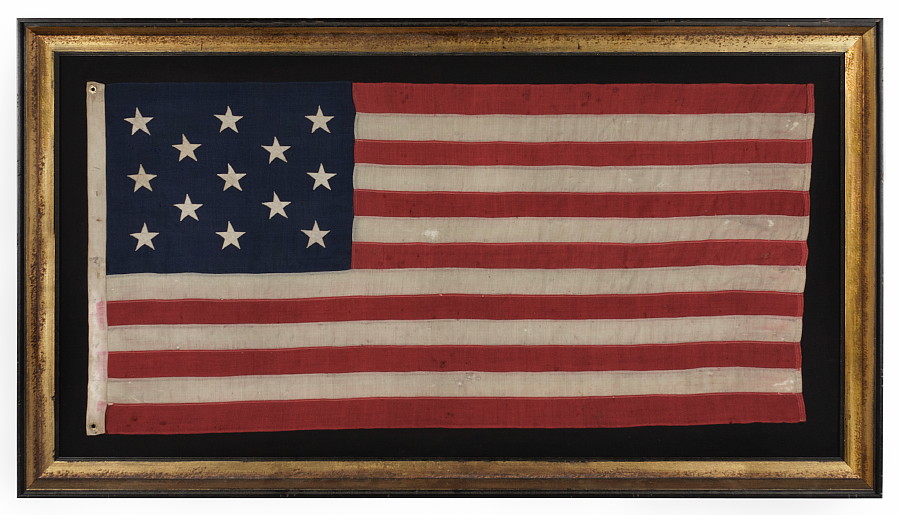
| |
ANTIQUE AMERICAN FLAG WITH 13 STARS IN A 3-2-3-2-3 PATTERN AND AN ELONGATED PROFILE, A SMALL-SCALE FLAG OF THE 1895-1926 ERA |
|
| Available: |
Sold |
| Frame Size (H x L): |
39.75" x 70" |
| Flag Size (H x L): |
29.25" x 59.5" |
|
| Description....: |
|
13 STARS IN A 3-2-3-2-3 PATTERN ON AN ELONGATED, SMALL-SCALE FLAG OF THE 1895-1926 ERA:
13 star flag of the type made from roughly the last decade of the 19th century through the first quarter of the 20th century. The stars are arranged in rows of 3-2-3-2-3, which is the most often seen pattern in 13 star flags of the late 19th and early 20th centuries. In most cases the 3-2-3-2-3 design can also be viewed as a diamond of stars, with a star in each corner and a star in the very center. It can also be interpreted as a combination of the crosses of St. Andrew and St. George, which some experts feel could have been the design of the very first American flag, serving as a link between this star pattern and the British Union Jack.
Why 13 Stars? The U.S. Navy had long been using 13 stars on its small-scale flags because they wished the stars to be easily discerned at a distance. This was the original number of stars on the American flag and equal to the number of original colonies. As the number of stars grew with the addition of new states, two circumstances occurred. One, it became more and more difficult to fit stars on a small flag and two, it became increasingly difficult to discern them from afar as individual objects.
For all practical purposes, commercial flag-makers simply didn't produce small flags like this one with pieced-and-sewn construction before the 1890's. There are exceptions to this rule, but until this time, the smallest sewn flags were no less than 6 feet on the fly. The primary use had long been more utilitarian than decorative, and flags needed to be large to be effective as signals. But private use grew with the passage of time, which led to the need for long-term use flags of more manageable scale.
Beginning around 1890, commercial flag-makers began to produce small flags for the first time in large quantities. Applying the same logic as the U.S. Navy, they chose the 13 star count rather than the full compliment of stars for sake of ease and visibility. Any flag that has previously been official, remains so according to the flag acts, so 13 star flags were and still are official today.
2 x 3 feet and 2.5 x 4 feet, were the most common sizes. This flag is a bit larger than most of its 13-star counterparts, but it is still very small when compared to most flags that carried the full complement of stars. The small size contributes a great deal to desirability because smaller flags are more easily framed and displayed an indoor setting.
Because there were no official proportions until 1912, American national flags came in many forms. The elongated profile of this particular flag resembles that of early nautical ensigns and lends an interesting appearance to the overall design.
13 star flags have been used throughout our Nation's history for a variety of purposes. In addition to their use on the small scale flags of the 1890-1920's era, the U.S. Navy used the 13 star count on small boats, both in the 18th century and through most or all of the 19th century, particularly the second half. Among other uses, 13 star flags were carried by soldiers during the Mexican and Civil Wars, distributed by politicians in campaigning for the presidency, and flown used at patriotic events, including Lafayette's visit in 1825-26, celebration of the nation's centennial of independence in 1876 and the sesquicentennial in 1926. The Navy's use of the 13 star flag ended in 1916 following an executive order written by President Woodrow Wilson.
Construction: The canton and stripes of the flag are made of wool bunting, pieced with a treadle machine. The cotton stars are machine-sewn with a zigzag stitch and double-appliqued (applied to both sides of the flag). The zigzag stitch was patented for use on flags in 1892 and went into widespread use shortly thereafter. There is a twill cotton sleeve with 2 brass grommets for hoisting.
Mounting: The flag has been stitched to 100% silk organza on every seam and throughout the star field for support. Then flag was then hand-sewn to background of 100% cotton twill, black in color, which was washed to reduce excess dye. An acid-free agent was added to the wash to further set the dye and the fabric was heat-treated for the same purpose. The flag was then placed in a black-painted and hand-gilded, contemporary Italian molding. The glazing is U.V. protective acrylic.
Condition: There is minor mothing throughout, accompanied by minor bleeding of the red dye at the fly end and on the hoist. There is very minor foxing and staining. There is a small punctured tear in the middle of the hoist binding. Fabric of similar coloration was placed behind the flag for both masking purposes and to strengthen its color against the dark background. Many of my clients prefer early flags to show their age and history of use. |
|
|
|
| Collector Level: |
Beginners and Holiday Gift Giving |
|
| Flag Type: |
Sewn flag |
|
| Star Count: |
13 |
|
| Earliest Date of Origin: |
1895 |
|
| Latest Date of Origin: |
1926 |
|
| State/Affiliation: |
13 Original Colonies |
|
| War Association: |
|
|
| Price: |
SOLD |
|
| |
Views: 5691 |
|
|
|

